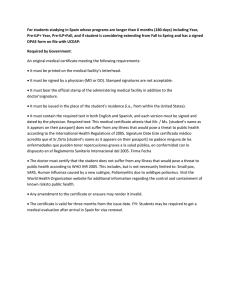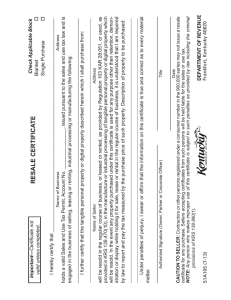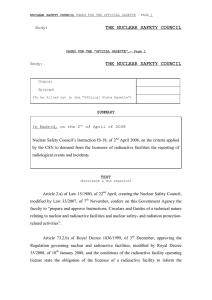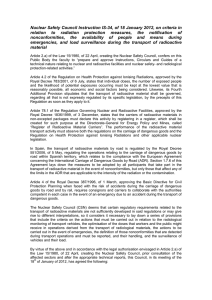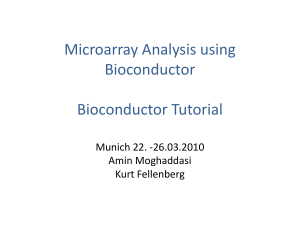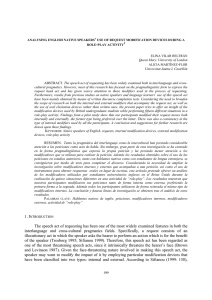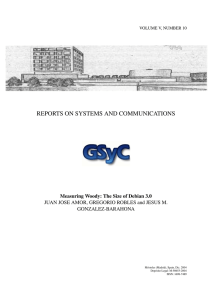IS-35
Anuncio
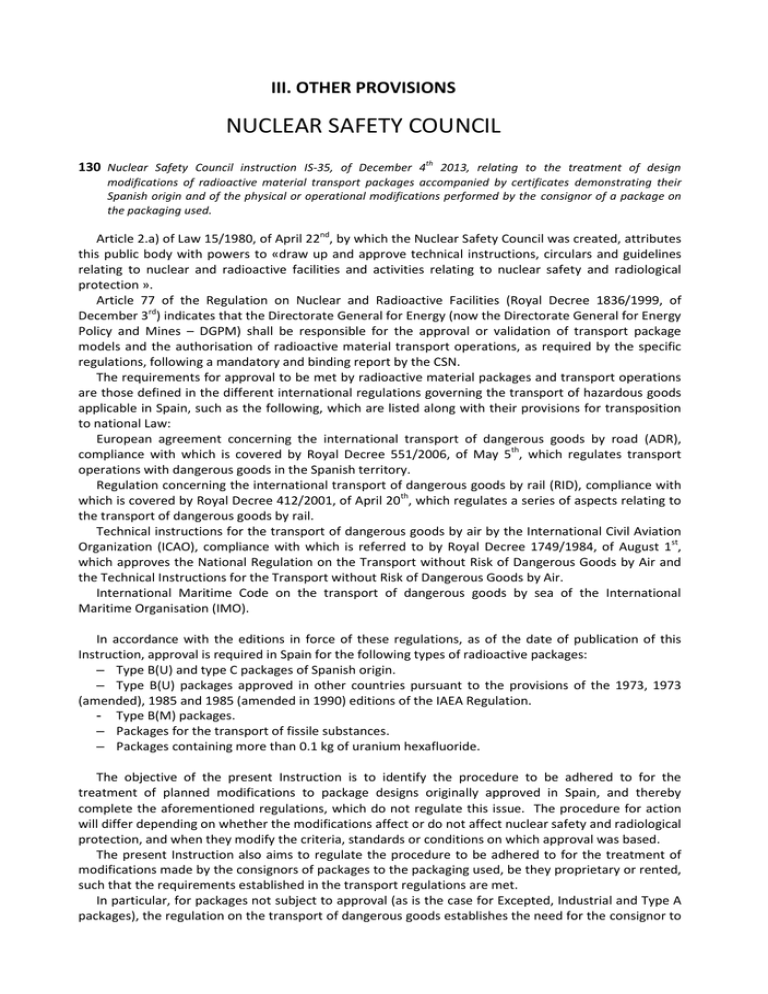
III. OTHER PROVISIONS NUCLEAR SAFETY COUNCIL 130 Nuclear Safety Council instruction IS-35, of December 4th 2013, relating to the treatment of design modifications of radioactive material transport packages accompanied by certificates demonstrating their Spanish origin and of the physical or operational modifications performed by the consignor of a package on the packaging used. Article 2.a) of Law 15/1980, of April 22nd, by which the Nuclear Safety Council was created, attributes this public body with powers to «draw up and approve technical instructions, circulars and guidelines relating to nuclear and radioactive facilities and activities relating to nuclear safety and radiological protection ». Article 77 of the Regulation on Nuclear and Radioactive Facilities (Royal Decree 1836/1999, of December 3rd) indicates that the Directorate General for Energy (now the Directorate General for Energy Policy and Mines – DGPM) shall be responsible for the approval or validation of transport package models and the authorisation of radioactive material transport operations, as required by the specific regulations, following a mandatory and binding report by the CSN. The requirements for approval to be met by radioactive material packages and transport operations are those defined in the different international regulations governing the transport of hazardous goods applicable in Spain, such as the following, which are listed along with their provisions for transposition to national Law: European agreement concerning the international transport of dangerous goods by road (ADR), compliance with which is covered by Royal Decree 551/2006, of May 5th, which regulates transport operations with dangerous goods in the Spanish territory. Regulation concerning the international transport of dangerous goods by rail (RID), compliance with which is covered by Royal Decree 412/2001, of April 20th, which regulates a series of aspects relating to the transport of dangerous goods by rail. Technical instructions for the transport of dangerous goods by air by the International Civil Aviation Organization (ICAO), compliance with which is referred to by Royal Decree 1749/1984, of August 1st, which approves the National Regulation on the Transport without Risk of Dangerous Goods by Air and the Technical Instructions for the Transport without Risk of Dangerous Goods by Air. International Maritime Code on the transport of dangerous goods by sea of the International Maritime Organisation (IMO). In accordance with the editions in force of these regulations, as of the date of publication of this Instruction, approval is required in Spain for the following types of radioactive packages: – Type B(U) and type C packages of Spanish origin. – Type B(U) packages approved in other countries pursuant to the provisions of the 1973, 1973 (amended), 1985 and 1985 (amended in 1990) editions of the IAEA Regulation. - Type B(M) packages. – Packages for the transport of fissile substances. – Packages containing more than 0.1 kg of uranium hexafluoride. The objective of the present Instruction is to identify the procedure to be adhered to for the treatment of planned modifications to package designs originally approved in Spain, and thereby complete the aforementioned regulations, which do not regulate this issue. The procedure for action will differ depending on whether the modifications affect or do not affect nuclear safety and radiological protection, and when they modify the criteria, standards or conditions on which approval was based. The present Instruction also aims to regulate the procedure to be adhered to for the treatment of modifications made by the consignors of packages to the packaging used, be they proprietary or rented, such that the requirements established in the transport regulations are met. In particular, for packages not subject to approval (as is the case for Excepted, Industrial and Type A packages), the regulation on the transport of dangerous goods establishes the need for the consignor to provide the competent authority with documentation demonstrating that the design meets the requirements of this regulation, if the said authority so requests. Consequently, in the case also of packages not subject to approval it is necessary to guarantee and document that any modification made to the design continues to fulfil the requirements established by the regulations for this type of package. Pursuant to the above and in keeping with the legal powers contemplated in article 2, section a), of Law 15/1980, of April 22nd, by which the Nuclear Safety Council was created, following consultations with the affected sectors and in the light of the appropriate technical reports, this Council agreed as follows during its meeting of December 4th 2013: One. Objective and scope of application. 1. The objective of the present Nuclear Safety Council Instruction is to identify the procedure to be adhered to for treatment of the modifications that the applicant plans to make to a package for the transport of radioactive material with a certificate of approval of Spanish origin. 2. The present Instruction also regulates the treatment of modifications made by the consignors of radioactive material transport packages to the packaging used, regardless of whether the package needs to have a design approval certificate in accordance with the requirements of the applicable regulations. 3. The present Instruction is applicable also to dual-purpose spent fuel casks, as regards the treatment of planned transport package design modifications. If such modifications affect the design of the cask for storage, their treatment should be governed also by the provisions of Nuclear Safety Council Instruction IS-20, of January 29th 2009, which establishes the safety requirements relating to spent fuel storage casks. 4. The present Instruction is applicable to those requesting approvals for package designs and their modifications, as well as to the consignors of radioactive packages, regardless of whether the package needs to have a design approval certificate. Two. Definitions. The definitions of the terms and concepts contained in the present Instruction correspond to those contained in the following provisions: - European agreement on the international transport of dangerous goods by road (ADR). - Regulation concerning the international transport of dangerous goods by rail (RID). - Technical instructions for the transport of dangerous goods by air by the International Civil Aviation Organization (ICAO). - International Maritime Code on the transport of dangerous goods by sea of the International Maritime Organisation (IMO). In addition, the following definitions are applicable for the purposes of the present Instruction: Certificate of approval of Spanish origin: Design approval for package designs originating in Spain. Routine transport conditions: Transport conditions free from incidents. Normal transport conditions: Transport conditions under which minor mishaps may occur. Transport accident conditions: Transport conditions including serious events potentially involving significant risk of damage to the packages. Dual-purpose spent fuel casks: Cask designed for two different purposes: the storage and transport of spent fuel, which according to the applicable standards requires two approvals, one for each of these uses. Package design: Description of the package (packaging and contents) allowing for its perfect identification. This description may include specifications, technical drawings, reports accrediting compliance with the regulatory requirements and any other pertinent documents. Design approval basis documents: Documentation submitted along with the application for transport package design approval that includes information on the following: package content specifications, packaging specifications, test report, package safety analysis report and quality assurance programme. Package safety analysis report: Document containing the information required for the performance of an analysis of the package from the point of view of nuclear safety and radiological protection and justifying compliance with each of the requirements established in the regulations for this type of package. Design modification: Changes to the design of the package. These changes include both physical changes to the package and changes in the conditions for use and maintenance, the analyses performed to demonstrate compliance with the design basis and the assessment methods used for these analyses. A minor design modification will be one that does not affect nuclear safety or radiological protection. Examples of such minor modifications might be minor changes to non safety-related components, changes to operation and maintenance procedures not affecting the operation of safety-related components, changes to the references included in drawings and documents deriving from changes in the quality system numbering conventions, corrections of errors detected or editorial changes to the package design approval basis documents. Applicant: Physical or legal entity requesting approval of the design or of a design modification of a transport package. Three. Design modifications of packages with a certificate of approval of Spanish origin. 1. Preliminary analysis. All design modifications must be evaluated by the applicant by means of a preliminary analysis, in order to verify whether they have a direct or indirect impact on nuclear safety or radiological protection. 1.1 If the preliminary analysis concludes that the modification does not have an impact on nuclear safety or radiological protection, it will be treated as a minor design modification. Such modifications may be carried out and the Nuclear Safety Council and the Directorate General for Energy Policy and Mines shall be informed within the first calendar quarter of each year. 1.2 If the preliminary analysis concludes that the changes do have an impact on nuclear safety or radiological protection, the applicant shall carry out a safety assessment. 2. Safety assessment. 2.1 The safety assessment is a detailed review carried out to check whether the criteria, standards and conditions on which the package design approval was based are modified in any way and to determine whether this should imply the revision of the package approval certificate. The assessment should include an analysis of the effects of the design modification on the structural, thermal, criticality, containment and shielding aspects of the package, as appropriate, and on its operation and maintenance procedures, as well as on the conditions established in the approval certificate. 2.2 A design modification will modify the criteria, standards and conditions on which the package design approval was based when it gives rise to circumstances such as the following: - Changes occur in the components of the package that might affect its performance with respect to nuclear safety and radiological protection under routine, normal and transport accident conditions. - The package operation and maintenance procedures change, leading to different situations or situations not analysed in the documentation on which the package design approval was based. - The analyses used in the basic design approval documents are modified, leading to less conservative results; i.e., for the same conditions a smaller safety margin is obtained with respect to the criteria defined in these documents. - The assessment or analysis method used is different from those used in the design approval basis documents. - A deviation occurs with respect to the conditions established in the package design approval certificate. 2.3 If the safety assessment concludes that the criteria, standards and conditions on which the package design approval was based continue to be fulfilled, the design modifications may be carried out and the Nuclear Safety Council and the Directorate General for Energy Policy and Mines shall be informed within the first calendar quarter of each year. 2.4 For this type of modifications, which do not imply revision of the package approval certificate, the applicant must define a procedure for their notification to users to whom the packaging has been provided. 2.5 In the case of modifications in which, following safety assessment, it is concluded that any of the criteria, standards and conditions on which the package design approval was based have varied, a revision of the corresponding approval certificate should be requested from the Ministry of Industry, Energy and Tourism, which must be issued prior to the modification taking effect. 2.6 In the case of design modifications requiring a request for the revision of the package design approval certificate, the request shall be accompanied by the following documentation: a) Technical description of the modifications, identifying the causes leading to such modifications. b) A safety analysis of the modification, identifying the applicable standards. This analysis shall demonstrate that the design of the package continues to meet the applicable safety criteria, standards and requirements following performance of the modification. c) A list of the changes introduced in each of the package design approval basis documents, identifying the cause for the design modifications (also listed here shall be the modifications identified in points 1.1 and 2.3 of this section, if included in the revision of the documentation submitted). d) Identification of whatever tests might be required prior to use of the package, when applicable. 3. The preliminary analysis and the safety assessment will be specific documents including the following: a description of the modification, the reason for the change, the affected basic design approval documents and the corresponding detailed analysis or assessment. 4. The applicant and the users of the packaging shall keep records of the design modifications, including the preliminary analyses and safety assessments, as appropriate. This documentation shall be controlled and kept in accordance with the specific requirements established in the applicable Quality Management Manual and shall be available to the Nuclear Safety Council and the Directorate General for Energy Policy and Mines if requested. Four. Terms for the updating of design approval basis documents, in the case of design modifications to packages with certificates of approval of Spanish origin. 1. In the case of design modifications not requiring a request for the revision of the package design approval certificate, the applicant shall update the approval basis documents submitted to the Nuclear Safety Council and the Directorate General for Energy Policy and Mines in the terms indicated below. 1.1 In the case of minor modifications, the updating should be performed within the shorter of the following time periods: - Three years as from performance of the modification. - Coinciding with the next renewal of the certificate. 1.2 For other modifications, not implying changes to the criteria, standards or conditions on which the approval of the package design was based, the basic documents should be updated within the shorter of the following time periods: - Two years as from performance of the modification. Coinciding with the next renewal of the certificate. Five. Control of physical or operational modifications performed by the consignor of a package to the packaging used. 1. Any modification that the consignor of a package, with or without a certificate of approval, wishes to perform on the packaging shall be assessed by means of a preliminary analysis in order to verify whether it has a direct or indirect impact on nuclear safety or radiological protection.1.1 If the preliminary analysis performed by the consignor concludes that the modification does not have any impact on nuclear safety or radiological protection, it shall be treated as a minor modification and may be carried out. 1.2 If the preliminary analysis performed by the consignor concludes that the changes may have an impact on nuclear safety or radiological protection, a safety assessment shall be carried out. 2. Safety assessment2.1 Safety assessments are detailed revisions performed in order to verify whether the modification to be performed will affect the following: a) In the case of packages subject to approval, the criteria, standards and conditions on which the package design approval was based. b) In the case of packages not subject to approval, the criteria, standards and conditions considered in the documentation issued to demonstrate that the design of the package meets the requirements of the applicable standards on the transport of dangerous goods. The assessment should include an analysis of the effects of the modification on the structural, thermal, criticality, containment and shielding aspects of the package, as appropriate, and on the corresponding operation and maintenance procedures. 2.2 If the safety assessment concludes that: 2.2.1 The changes do not modify the criteria, standards and conditions on which the package design approval was based or those considered in the documentation issued to demonstrate that the design of the package not subject to approval meets the regulatory requirements, the consignor may carry out the modification. 2.2.2 The changes modify the aforementioned criteria, standards and conditions, the consignor may not carry out the modification until: a) In the case of packages subject to approval, the revision of the package approval certificate is available. b) In the case of packages not subject to approval, the revision of the documentation demonstrating that the design of the package meets the applicable requirements is available. 2.3 The results of the safety assessments performed should be accompanied by the documented acceptance of the designer of the package. 3. The consignor of the package shall keep records of the modifications performed, including the preliminary analyses and safety assessments, as appropriate. This documentation shall be controlled and kept in accordance with the requirements established in the consignor’s Quality Management Manual. Six. Infringements and sanctions. The present Nuclear Safety Council Instruction is binding, as established in article 2.a) of Law 15/1980, of April 22nd, by which the Nuclear Safety Council was created, for which reason any infringement thereof will be penalised as set out in Chapter XIV (articles 85 to 93) of the Nuclear Energy Act, Law 25/1964, of April 29th. Single derogatory provision. Any standard of equal or lower standing that opposes the present Instruction is hereby made null and void. Single final provision. The present Instruction will enter into force on the day following its publication in the «Official State Gazette». Madrid, December 4th 2013.–The President of the Nuclear Safety Council, Fernando Marti Scharfhausen.

